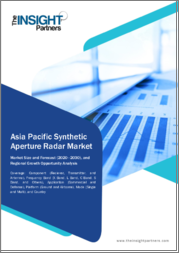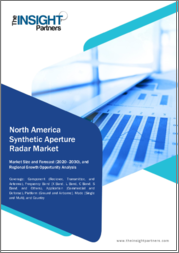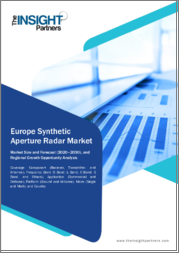
|
시장보고서
상품코드
1567888
아시아태평양의 합성 개구 레이더(SAR) 시장 전망(-2030년) : 지역별 분석 - 구성요소별, 주파수 대역별, 용도별, 플랫폼별, 모드별Asia Pacific Synthetic Aperture Radar Market Forecast to 2030 - Regional Analysis - by Component, Frequency Band, Application, Platform, and Mode |
||||||
아시아태평양의 합성 개구 레이더(SAR) 시장은 2022년에 11억 4,044만 달러, 2030년까지 28억 2,314만 달러에 달할 것으로 예상되며, 2022-2030년간 12.0%의 연평균 복합 성장률(CAGR)을 나타낼 것으로 예상됩니다.
듀얼 밴드 SAR의 개발로 아시아태평양의 합성 개구 레이더(SAR) 시장 성장 촉진
듀얼 밴드 합성 개구 레이더(SAR) 기술은 두 개의 주파수 대역에서 동시에 작동하여 단일 밴드 SAR 시스템보다 이미징 능력을 향상시키고 이미지 품질을 향상시킵니다. 듀얼 밴드 SAR을 사용하면 몇 가지 장점이 있습니다. 첫째, 두 개의 서로 다른 주파수 대역을 결합하여 보다 상세하고 정확한 이미징이 가능하기 때문에 목표물을 쉽게 식별하고 식별할 수 있습니다. 이는 군사 감시, 국경 관리, 해상 감시와 같이 물체를 식별하고 미묘한 변화를 감지하는 능력이 중요한 응용 분야에서 특히 유용합니다.
두 번째로, 듀얼 밴드 SAR 기술은 열악한 환경 조건에서도 물체를 투과하고 감지할 수 있는 능력을 향상시키며, 두 개의 서로 다른 주파수 대역을 사용함으로써 SAR 시스템은 초목, 날씨, 표면 거칠기 등의 요인으로 인한 제한을 극복할 수 있습니다. 이러한 향상된 견고성은 악조건에서도 안정적인 이미징을 가능하게 하여 SAR 기술의 적용 범위를 넓힐 수 있습니다. 또한, 듀얼밴드 SAR 시스템의 향상된 이미지 품질은 획득한 데이터의 해석과 분석을 용이하게 합니다. 이는 재난 관리, 환경 모니터링, 인프라 계획 등 정확하고 상세한 정보가 의사 결정에 필수적인 분야에 특히 유용합니다. 이처럼 듀얼밴드 합성 개구 레이더(SAR) 기술은 합성 개구 레이더(SAR) 시장에서 중요한 발전으로 등장하여 시장 성장과 확장에 새로운 기회를 제공합니다.
아시아태평양의 합성 개구 레이더(SAR) 시장 개요
아시아태평양의 합성 개구 레이더(SAR) 시장은 호주, 중국, 인도, 일본, 한국, 기타 아시아태평양으로 구분됩니다. 환경 감시, 재난 관리, 해상 감시, 표적 탐지 등 원격 감지 응용 분야에서 합성 개구 레이더의 응용이 확대됨에 따라 각 지역은 합성 개구 레이더 개발에 주력하고 있습니다. 예를 들어, 2023년 10월 인도네시아 발리에서 '아시아태평양의 합성 개구 레이더 회의(APSAR)'라는 국제 회의가 개최되었습니다. 이 회의는 합성 개구 레이더의 기술 개발과 응용을 주제로 했습니다. 이 회의는 2023 IEEE International Conference on Aerospace Electronics and Remote Sensing Technology(ICARES 2023)와 공동 개최되었습니다.
합성 개구 레이더 개발을 위해 아시아태평양의 여러 기업들이 파트너십을 맺고 있습니다. 예를 들어, 2023년 10월 Data Patterns는 우주 결절 기관인 IN-SPACe와 합성 개구 레이더(SAR) 개발을 위한 라이선스 및 기술이전(ToT) 계약을 체결했습니다. 이 파트너십은 데이터패턴스의 레이더 개발 노력을 지원할 예정입니다.
중국은 몬순 기후의 영향을 많이 받아 기상재해가 자주 발생합니다. 중국은 또한 심각한 산사태, 홍수 및 기타 지질 재해를 경험했습니다. 따라서 중국은 간섭합성 개구 레이더(InSAR) 위성 배치에 중점을 두고 있습니다. 예를 들어, 중국은 2023년 3월 중국 북부 산시성 타이위안위성발사센터에서 중국 민간 위성개발업체 갤럭시스페이스(GalaxySpace)가 개발한 간섭합성 개구 레이더(InSAR) 위성 4기를 CZ-2D 로켓에 실어 발사했습니다. 이 유형의 위성은 비교적 안정적인 포메이션 구성과 높은 매핑 효율을 제공합니다. 이 위성은 밀리미터 단위의 변형 모니터링 능력을 갖추고 있어 복잡한 지역의 주요 지질 재해를 조기에 파악할 수 있는 강력한 도구가 될 수 있습니다. 탐사 및 지반 침하, 붕괴, 산사태 및 기타 재해 예방에 유용한 데이터를 제공할 수 있습니다. 이러한 사례는 아시아태평양의 합성 개구 레이더(SAR) 시장의 성장을 견인하고 있습니다.
아시아태평양의 합성 개구 레이더(SAR) 시장 매출 및 2030년까지의 예측(금액)
아시아태평양의 합성 개구 레이더(SAR) 시장 세분화
아시아태평양의 합성 개구 레이더(SAR) 시장은 구성 요소, 주파수 대역, 용도, 플랫폼, 모드 및 국가별로 분류됩니다.
구성 요소에 따라 아시아태평양의 합성 조리개 레이더 시장은 수신기, 송신기 및 안테나로 분류됩니다. 안테나 부문은 2022년 가장 큰 시장 점유율을 차지했습니다.
주파수 대역별로 아시아태평양의 합성 개구 레이더(SAR) 시장은 x밴드, l밴드, c밴드, s밴드, 기타로 분류되며, 2022년에는 x밴드 부문이 가장 큰 시장 점유율을 차지할 것으로 예상됩니다.
용도별로 아시아태평양의 합성 개구 레이더(SAR) 시장은 상업용과 방산용으로 구분되며, 2022년 시장 점유율은 방산 분야가 차지할 것으로 예상됩니다.
플랫폼별로 아시아태평양의 합성 개구 레이더(SAR) 시장은 지상용과 공중용으로 나뉘며, 2022년 시장 점유율은 항공기 부문이 차지할 것으로 예상됩니다.
모드별로는 아시아태평양의 합성 개구 레이더(SAR) 시장은 단일과 다중으로 나뉘며, 2022년 다중 시장 점유율이 더 클 것으로 예상됩니다.
국가별로 아시아태평양의 합성 개구 레이더(SAR) 시장은 호주, 일본, 인도, 중국, 한국, 기타 아시아태평양으로 구분되며, 2022년 아시아태평양의 합성 개구 레이더(SAR) 시장 점유율은 중국이 독차지했습니다.
Northrop Grumman Corp, ASELSAN AS, BAE Systems Plc, Israel Aerospace Industries Ltd, Leonardo SpA, Lockheed Martin Corp, Raytheon Technologies Corp, Thales SA, Saab AB는 아시아태평양의 합성 개구 레이더(SAR) 시장에서 활동하는 주요 기업 중 일부입니다.
목차
제1장 서론
제2장 주요 요약
- 주요 인사이트
- 시장의 매력
제3장 조사 방법
- 조사 범위
- 2차 조사
- 1차 조사
제4장 아시아태평양의 합성 개구 레이더(SAR) 시장 전망
- 생태계 분석
제5장 아시아태평양의 합성 개구 레이더(SAR) 시장 : 주요 시장 역학
- 시장 성장 촉진요인
- 시장 성장 억제요인
- 시장 기회
- 향후 동향
- 성장 촉진요인과 억제요인의 영향
제6장 합성 개구 레이더(SAR) 시장 : 아시아태평양 시장 분석
- 아시아태평양의 합성 개구 레이더(SAR) 시장 매출, 2020년-2030년
- 합성 개구 레이더(SAR) 시장 예측 분석
제7장 아시아태평양의 합성 개구 레이더(SAR) 시장 분석 - 컴포넌트별
- 수신기
- 송신기
- 안테나
제8장 아시아태평양의 합성 개구 레이더(SAR) 시장 분석 - 주파수대별
- X band
- L band
- C band
- S band
- 기타
제9장 아시아태평양의 합성 개구 레이더(SAR) 시장 분석 - 용도별
- 상업
- 방위
제10장 아시아태평양의 합성 개구 레이더(SAR) 시장 분석 - 플랫폼별
- 육상
- 낙하산
제11장 아시아태평양의 합성 개구 레이더(SAR) 시장 분석 - 모드별
- 싱글
- 멀티
제12장 아시아태평양의 합성 개구 레이더(SAR) 시장 - 국가별 분석
- 아시아태평양
- 호주
- 일본
- 인도
- 중국
- 한국
- 기타 아시아태평양
제13장 산업 전망
- 시장 이니셔티브
- 제품 개발
- 파트너십과 협업
- 사업 확대
- 기타
제14장 기업 개요
- Northrop Grumman Corp
- ASELSAN AS
- BAE Systems Plc
- Israel Aerospace Industries Ltd
- Leonardo SpA
- Lockheed Martin Corp
- Raytheon Technologies Corp
- Thales SA
- Saab AB
제15장 부록
LSH 24.10.31The Asia Pacific synthetic aperture radar market was valued at US$ 1,140.44 million in 2022 and is expected to reach US$ 2,823.14 million by 2030; it is estimated to register a CAGR of 12.0% from 2022 to 2030.
Rising Development of Dual-Band SAR Boosts Asia Pacific Synthetic Aperture Radar Market
Dual-band synthetic aperture radar (SAR) technology operates in two frequency bands simultaneously, allowing for enhanced imaging capabilities and improved image quality compared to single-band SAR systems. The use of dual-band SAR offers several advantages. Firstly, it enables better target discrimination and identification, as the combination of two different frequency bands provides more detailed and accurate imaging. This is particularly valuable in applications such as military surveillance, border control, and maritime monitoring, where the ability to distinguish between objects and detect subtle changes is crucial.
Secondly, dual-band SAR technology enhances the system's ability to penetrate and detect objects under challenging environmental conditions. Utilizing two different frequency bands, SAR systems can overcome limitations posed by factors such as vegetation cover, weather conditions, and surface roughness. This increased robustness allows for reliable imaging even in adverse conditions, expanding the range of applications for SAR technology. Moreover, the improved image quality offered by dual-band SAR systems facilitates better interpretation and analysis of the acquired data. This is particularly beneficial in applications such as disaster management, environmental monitoring, and infrastructure planning, where accurate and detailed information is vital for decision-making. Thus, dual-band synthetic aperture radar (SAR) technology has emerged as a significant advancement in the synthetic aperture radar market, presenting new opportunities for market growth and expansion.
Asia Pacific Synthetic Aperture Radar Market Overview
The Asia Pacific synthetic aperture radar market is segmented into Australia, China, India, Japan, South Korea, and the Rest of Asia Pacific. The growing application of synthetic aperture radar in remote sensing applications such as environment monitoring, disaster management, maritime surveillance, and target detection enables regions to focus on the development of synthetic aperture radar. For example, in October 2023, an international conference, the Asia Pacific Conference on Synthetic Aperture Radar (APSAR), was held on Bali Island, Indonesia. The conference was devoted to synthetic aperture radar technology development and applications. This conference was jointly hosted with the 2023 IEEE International Conference on Aerospace Electronics and Remote Sensing Technology (ICARES 2023).
Several players across Asia Pacific are entering into partnerships for the development of synthetic aperture radar. For example, in October 2023, Data Patterns entered into a licensing and transfer of technology (ToT) agreement with space nodal agency IN-SPACe for Synthetic Aperture Radar (SAR) development. The partnership will help Data Patterns in radar development efforts.
China is severely affected by monsoon weather and frequent meteorological disasters. China also has experienced severe landslides, floodwaters, and other geological hazards. Thus, China has emphasized the deployment of interferometric synthetic aperture radar (InSAR) satellites. For example, in March 2023, China launched four interferometric synthetic aperture radar (InSAR) satellites developed by Chinese private satellite developer GalaxySpace using the CZ-2D rocket at the Taiyuan Satellite launch center in North China's Shanxi province. This type of satellite provides comparatively stable formation configuration and high mapping efficiency. The satellites are a powerful tool for the early identification of major geological hazards in complex areas due to their millimeter-level deformation monitoring capability. They can provide data support for exploration and the prevention of land subsidence, collapse, landslides, and other disasters. Thus, such instances drive the growth of the synthetic aperture radar market in Asia Pacific.
Asia Pacific Synthetic Aperture Radar Market Revenue and Forecast to 2030 (US$ Million)
Asia Pacific Synthetic Aperture Radar Market Segmentation
The Asia Pacific synthetic aperture radar market is categorized into component, frequency band, application, platform, mode, and country.
Based on component, the Asia Pacific synthetic aperture radar market is categorized into receiver, transmitter, and antenna. The antenna segment held the largest market share in 2022.
In terms of frequency band, the Asia Pacific synthetic aperture radar market is categorized into x band, l band, c band, s band, and others. The x band segment held the largest market share in 2022.
By application, the Asia Pacific synthetic aperture radar market is segmented into commercial and defense. The defense segment held a larger market share in 2022.
Based on platform, the Asia Pacific synthetic aperture radar market is bifurcated into ground and airborne. The airborne segment held a larger market share in 2022.
In terms of mode, the Asia Pacific synthetic aperture radar market is bifurcated into single and multi. The multi segment held a larger market share in 2022.
By country, the Asia Pacific synthetic aperture radar market is segmented into Australia, Japan, India, China, South Korea, and the Rest of Asia Pacific. China dominated the Asia Pacific synthetic aperture radar market share in 2022.
Northrop Grumman Corp, ASELSAN AS, BAE Systems Plc, Israel Aerospace Industries Ltd, Leonardo SpA, Lockheed Martin Corp, Raytheon Technologies Corp, Thales SA, and Saab AB are some of the leading companies operating in the Asia Pacific synthetic aperture radar market.
Table Of Contents
1. Introduction
- 1.1 The Insight Partners Research Report Guidance
- 1.2 Market Segmentation
2. Executive Summary
- 2.1 Key Insights
- 2.2 Market Attractiveness
3. Research Methodology
- 3.1 Coverage
- 3.2 Secondary Research
- 3.3 Primary Research
4. Asia Pacific Synthetic Aperture Radar Market Landscape
- 4.1 Overview
- 4.2 Ecosystem Analysis
5. Asia Pacific Synthetic Aperture Radar Market - Key Market Dynamics
- 5.1 Market Drivers
- 5.1.1 Increasing Preference for Ensuring Precision Targeting Capability
- 5.1.2 Rising Preference for Integrated C4ISR Ecosystem
- 5.1.3 Growing Demand for Earth Observation and Remote Sensing Capabilities
- 5.2 Market Restraints
- 5.2.1 Satellite Launch Delays
- 5.2.2 High Development Cost
- 5.3 Market Opportunities
- 5.3.1 Rising Development of Dual-Band SAR
- 5.3.2 Increasing Use of SAR in Agriculture Industry
- 5.4 Future Trends
- 5.4.1 Integration with Deep Learning (DL)
- 5.5 Impact of Drivers and Restraints:
6. Synthetic Aperture Radar Market - Asia Pacific Market Analysis
- 6.1 Asia Pacific Synthetic Aperture Radar Market Revenue (US$ Million), 2020-2030
- 6.2 Synthetic Aperture Radar Market Forecast Analysis
7. Asia Pacific Synthetic Aperture Radar Market Analysis - by Component
- 7.1 Receiver
- 7.1.1 Overview
- 7.1.2 Receiver: Synthetic Aperture Radar Market - Revenue and Forecast to 2030 (US$ Million)
- 7.2 Transmitter
- 7.2.1 Overview
- 7.2.2 Transmitter: Synthetic Aperture Radar Market - Revenue and Forecast to 2030 (US$ Million)
- 7.3 Antenna
- 7.3.1 Overview
- 7.3.2 Antenna: Synthetic Aperture Radar Market - Revenue and Forecast to 2030 (US$ Million)
8. Asia Pacific Synthetic Aperture Radar Market Analysis - by Frequency Band
- 8.1 X Band
- 8.1.1 Overview
- 8.1.2 X Band: Synthetic Aperture Radar Market - Revenue and Forecast to 2030 (US$ Million)
- 8.2 L Band
- 8.2.1 Overview
- 8.2.2 L Band: Synthetic Aperture Radar Market - Revenue and Forecast to 2030 (US$ Million)
- 8.3 C Band
- 8.3.1 Overview
- 8.3.2 C Band: Synthetic Aperture Radar Market - Revenue and Forecast to 2030 (US$ Million)
- 8.4 S Band
- 8.4.1 Overview
- 8.4.2 S Band: Synthetic Aperture Radar Market - Revenue and Forecast to 2030 (US$ Million)
- 8.5 Others
- 8.5.1 Overview
- 8.5.2 Others: Synthetic Aperture Radar Market - Revenue and Forecast to 2030 (US$ Million)
9. Asia Pacific Synthetic Aperture Radar Market Analysis - by Application
- 9.1 Commercial
- 9.1.1 Overview
- 9.1.2 Commercial: Synthetic Aperture Radar Market - Revenue and Forecast to 2030 (US$ Million)
- 9.2 Defense
- 9.2.1 Overview
- 9.2.2 Defense: Synthetic Aperture Radar Market - Revenue and Forecast to 2030 (US$ Million)
10. Asia Pacific Synthetic Aperture Radar Market Analysis - by Platform
- 10.1 Ground
- 10.1.1 Overview
- 10.1.2 Ground: Synthetic Aperture Radar Market - Revenue and Forecast to 2030 (US$ Million)
- 10.2 Airborne
- 10.2.1 Overview
- 10.2.2 Airborne: Synthetic Aperture Radar Market - Revenue and Forecast to 2030 (US$ Million)
11. Asia Pacific Synthetic Aperture Radar Market Analysis - by Mode
- 11.1 Single
- 11.1.1 Overview
- 11.1.2 Single: Synthetic Aperture Radar Market - Revenue and Forecast to 2030 (US$ Million)
- 11.2 Multi
- 11.2.1 Overview
- 11.2.2 Multi: Synthetic Aperture Radar Market - Revenue and Forecast to 2030 (US$ Million)
12. Asia Pacific Synthetic Aperture Radar Market - Country Analysis
- 12.1 Asia Pacific Synthetic Aperture Radar Market - Country Analysis
- 12.1.1 Asia Pacific: Synthetic Aperture Radar Market - Revenue and Forecast Analysis - by Country
- 12.1.1.1 Asia Pacific: Synthetic Aperture Radar Market - Revenue and Forecast Analysis - by Country
- 12.1.1.2 Australia: Synthetic Aperture Radar Market - Revenue and Forecast to 2030 (US$ Million)
- 12.1.1.2.1 Australia: Synthetic Aperture Radar Market Breakdown, by Component
- 12.1.1.2.2 Australia: Synthetic Aperture Radar Market Breakdown, by Frequency Band
- 12.1.1.2.3 Australia: Synthetic Aperture Radar Market Breakdown, by Application
- 12.1.1.2.4 Australia: Synthetic Aperture Radar Market Breakdown, by Platform
- 12.1.1.2.5 Australia: Synthetic Aperture Radar Market Breakdown, by Mode
- 12.1.1.3 Japan: Synthetic Aperture Radar Market - Revenue and Forecast to 2030 (US$ Million)
- 12.1.1.3.1 Japan: Synthetic Aperture Radar Market Breakdown, by Component
- 12.1.1.3.2 Japan: Synthetic Aperture Radar Market Breakdown, by Frequency Band
- 12.1.1.3.3 Japan: Synthetic Aperture Radar Market Breakdown, by Application
- 12.1.1.3.4 Japan: Synthetic Aperture Radar Market Breakdown, by Platform
- 12.1.1.3.5 Japan: Synthetic Aperture Radar Market Breakdown, by Mode
- 12.1.1.4 India: Synthetic Aperture Radar Market - Revenue and Forecast to 2030 (US$ Million)
- 12.1.1.4.1 India: Synthetic Aperture Radar Market Breakdown, by Component
- 12.1.1.4.2 India: Synthetic Aperture Radar Market Breakdown, by Frequency Band
- 12.1.1.4.3 India: Synthetic Aperture Radar Market Breakdown, by Application
- 12.1.1.4.4 India: Synthetic Aperture Radar Market Breakdown, by Platform
- 12.1.1.4.5 India: Synthetic Aperture Radar Market Breakdown, by Mode
- 12.1.1.5 China: Synthetic Aperture Radar Market - Revenue and Forecast to 2030 (US$ Million)
- 12.1.1.5.1 China: Synthetic Aperture Radar Market Breakdown, by Component
- 12.1.1.5.2 China: Synthetic Aperture Radar Market Breakdown, by Frequency Band
- 12.1.1.5.3 China: Synthetic Aperture Radar Market Breakdown, by Application
- 12.1.1.5.4 China: Synthetic Aperture Radar Market Breakdown, by Platform
- 12.1.1.5.5 China: Synthetic Aperture Radar Market Breakdown, by Mode
- 12.1.1.6 South Korea: Synthetic Aperture Radar Market - Revenue and Forecast to 2030 (US$ Million)
- 12.1.1.6.1 South Korea: Synthetic Aperture Radar Market Breakdown, by Component
- 12.1.1.6.2 South Korea: Synthetic Aperture Radar Market Breakdown, by Frequency Band
- 12.1.1.6.3 South Korea: Synthetic Aperture Radar Market Breakdown, by Application
- 12.1.1.6.4 South Korea: Synthetic Aperture Radar Market Breakdown, by Platform
- 12.1.1.6.5 South Korea: Synthetic Aperture Radar Market Breakdown, by Mode
- 12.1.1.7 Rest of Asia Pacific: Synthetic Aperture Radar Market - Revenue and Forecast to 2030 (US$ Million)
- 12.1.1.7.1 Rest of Asia Pacific: Synthetic Aperture Radar Market Breakdown, by Component
- 12.1.1.7.2 Rest of Asia Pacific: Synthetic Aperture Radar Market Breakdown, by Frequency Band
- 12.1.1.7.3 Rest of Asia Pacific: Synthetic Aperture Radar Market Breakdown, by Application
- 12.1.1.7.4 Rest of Asia Pacific: Synthetic Aperture Radar Market Breakdown, by Platform
- 12.1.1.7.5 Rest of Asia Pacific: Synthetic Aperture Radar Market Breakdown, by Mode
- 12.1.1 Asia Pacific: Synthetic Aperture Radar Market - Revenue and Forecast Analysis - by Country
13. Industry Landscape
- 13.1 Overview
- 13.2 Market Initiative
- 13.3 Product Development
- 13.4 Partnership & Collaboration
- 13.5 Expansion
- 13.6 Others
14. Company Profiles
- 14.1 Northrop Grumman Corp
- 14.1.1 Key Facts
- 14.1.2 Business Description
- 14.1.3 Products and Services
- 14.1.4 Financial Overview
- 14.1.5 SWOT Analysis
- 14.1.6 Key Developments
- 14.2 ASELSAN AS
- 14.2.1 Key Facts
- 14.2.2 Business Description
- 14.2.3 Products and Services
- 14.2.4 Financial Overview
- 14.2.5 SWOT Analysis
- 14.2.6 Key Developments
- 14.3 BAE Systems Plc
- 14.3.1 Key Facts
- 14.3.2 Business Description
- 14.3.3 Products and Services
- 14.3.4 Financial Overview
- 14.3.5 SWOT Analysis
- 14.3.6 Key Developments
- 14.4 Israel Aerospace Industries Ltd
- 14.4.1 Key Facts
- 14.4.2 Business Description
- 14.4.3 Products and Services
- 14.4.4 Financial Overview
- 14.4.5 SWOT Analysis
- 14.4.6 Key Developments
- 14.5 Leonardo SpA
- 14.5.1 Key Facts
- 14.5.2 Business Description
- 14.5.3 Products and Services
- 14.5.4 Financial Overview
- 14.5.5 SWOT Analysis
- 14.5.6 Key Developments
- 14.6 Lockheed Martin Corp
- 14.6.1 Key Facts
- 14.6.2 Business Description
- 14.6.3 Products and Services
- 14.6.4 Financial Overview
- 14.6.5 SWOT Analysis
- 14.6.6 Key Developments
- 14.7 Raytheon Technologies Corp
- 14.7.1 Key Facts
- 14.7.2 Business Description
- 14.7.3 Products and Services
- 14.7.4 Financial Overview
- 14.7.5 SWOT Analysis
- 14.7.6 Key Developments
- 14.8 Thales SA
- 14.8.1 Key Facts
- 14.8.2 Business Description
- 14.8.3 Products and Services
- 14.8.4 Financial Overview
- 14.8.5 SWOT Analysis
- 14.8.6 Key Developments
- 14.9 Saab AB
- 14.9.1 Key Facts
- 14.9.2 Business Description
- 14.9.3 Products and Services
- 14.9.4 Financial Overview
- 14.9.5 SWOT Analysis
- 14.9.6 Key Developments
15. Appendix
- 15.1 About The Insight Partners
- 15.2 Word Index



















